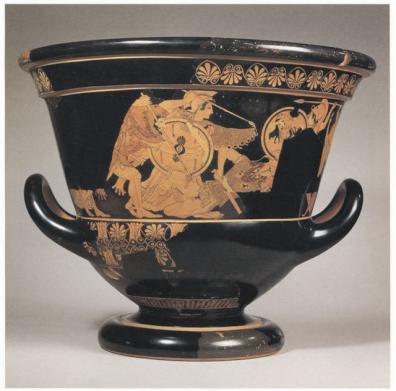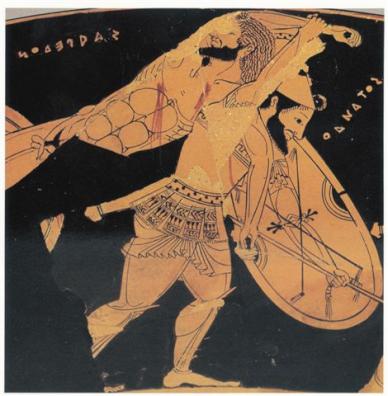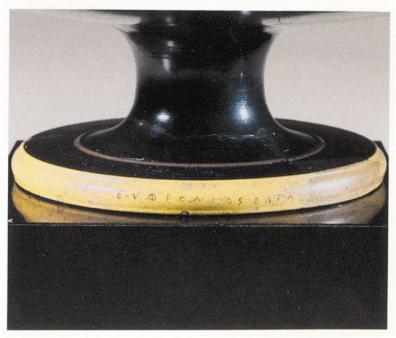Suzan Mazur: Euphronios Ancient Art In Court
When A Cup Is Not A Cup: Euphronios Ancient Art In Court
By Suzan Mazur
The antiquities trial which opens November 16 in Rome has put two of the ancient art world's biggest names in the hot seat -- former Getty museum curator Marion True and dealer Robert Hecht, an 86-year old department store-heir -- each charged with trafficking in stolen art (Italian prosecutors say they have Polaroid documentation). But more important is the corruption the trial will undoubtedly highlight and splash around world news about museum-dealer-collector collaboration in general.
Italy is seeking the return of a long list of treasures now housed in America's major museums, among them the Metropolitan (eight pieces), the Getty (42 pieces) and Princeton. [Click here: Bloomberg.com -"Tomb-Robbing Trials Name Getty, Metropolitan, Princeton Museums" ]
The Met's 2,500-year old krater (vase) by Athenian painter and potter Euphronios (520bc-470bc) is at the top of the Italian government's list. It bears the narrative from Homer's Iliad of the death on the Trojan battlefield of the Lycian hero Sarpedon, son of Zeus.
Euphronios only signed eighteen known vases, six times as painter and twelve times as potter.
The Met purchased the Euphronios vase from Bob Hecht in 1972 for $1m when Thomas Hoving was the museum's director.
The Italians claim the krater was looted in 1971 from Cerveteri, a necropolis near Rome and that Hecht bought it from another dealer, Giacomo Medici, who is now appealing a 10-year antiquities trafficking sentence. [Click here: Italy Says It's Proven Vase at Met Was Looted - Los Angeles Times ]
Also on Italy's list and on exhibit at the Met is the signed-Euphronios fragmentary vase (calyx krater) depicting the death of Kyknos in battle, which Sotheby's auctioned from the Nelson Bunker Hunt collection in 1990. Sotheby's spokesman Matthew Weigman, returning my call, said the piece was sold at the time to a "European buyer". It currently belongs to collectors Leon Levy and Shelby White and has been on loan to the Met since 1999.

Fragmentary Calyx Krater (vase -- circa 510bc) signed by Euphronios. Depicts the death of Kyknos in battle with Herakles. Height 17-3/4" and 75% plastic sold at Sotheby's, New York in 1990 for $1.7m from the Nelson Bunker Hunt collection.
Image: Sotheby's, New York The auction catalogue reads: " The Hunt calyx krater, in grandeur of form, style and subject, relates closely to the two relatively complete examples signed by Euphronios, those in the Louvre and the Metropolitan Museum of Art, the first painted with the combat between Herakles and Antaios, the second with the death of Sarpedon, a subject which he repeats, later in the narrative, on the Hunt kylix."
[Click here: artnet.com Magazine Features - Super Art Gems of New York City ]
But where is the Euphronios-painted wine cup (kylix) from the Bunker Hunt collection that Weigman said Sotheby's also sold to a "European buyer"? Sotheby's Nelson Bunker Hunt Collection: Highly Important Greek Vases catalogue (6/19/90) notes the following:
"This cup may be the earliest extant work by Euphronios, preceding by about a decade the Hunt krater with the death of Hypnos [Kyknos?]. It shows the first known representation of the removal of the body of Sarpedon from the battlefield of Troy."
It is the same narrative painted on the complete Euphronios-painted vase, a prized exhibit at the Met for the last 33 years, and surely must also be among the pieces Italian prosecutors are after.

Kylix (Wine Cup -- Circa 520bc) Signed By Euphronios, One Of The Greats Of Greek Vase Painting. Height 4-13/16", Rim Diameter 13-1/16" Sold At Auction At Sotheby's, New York For $742,000 In 1990 From Nelson Bunker Hunt Collection. Image Credit: Sotheby's, New York

Wine cup details: Lycian hero Sarpedon from Homer's Iliad, bleeding as he is carried away from Trojan battlefield by Thanatos, god of death.
Image--Sotheby's, New York
Hecht attempted to sell the Euphronios cup to Hoving in the 1970s for $70,000 (see my Economist story excerpted below) after his sale of the vase, but Hoving was uneasy about the sale and said no. The Met's Greek and Roman department says the cup is not on exhibit there now and does not believe it is part of the Shelby White collection. Bunker Hunt's office doesn't know where the cup is either.
Former Getty antiquities curator Marion True returned a Euphronios wine cup to Italy in 1999, which the Italians claim was also looted from Cerveteri, but apparently not the one that once belonged to Bunker Hunt.
The Getty cup had two signatures: Euphronios as potter, and Onesimos as painter. The cup Sotheby's auctioned had one signature: "Euphronios painted [this]".

Wine Cup Base Reads "Euphronios Painted [This]" Image: Sotheby's, New York
While the statute of limitations regarding civil and criminal claims on repatriation has now run out for the Italians, they are nevertheless proceeding in the case on moral grounds. The trial should be a fascinating one. Bob Hecht is the grand wizard of the antiquities world. He knows everybody and every thing.
Following are excerpts from my 6/23/90 Economist story,"The Hunts' hoard on the auction block". After publication of the article, Hecht attempted to punch me in the face at an exhibition at New York art dealer Michael Ward's place:
"On the night, everyone of note was there; excitement among collectors, dealers and cognoscenti was "absolutely palpable". The pieces included Bunker Hunt's favourites, a signed wine cup and fragment of a vase by Euphronios, the master of Greek vase painting; Sotheby's has never before handled a signed piece by an ancient artist.
The cup went for $742,000, the vase-fragment (75% plastic) [according to Sotheby's] for $1.7m. A Roman bronze of a young man went for $539,000. [I was present at a small informal chat in New York prior to the auction with dealer Bob Hecht and some less visible antiquities figures, when Hecht revealed that the bronze nude, which later went to a Japanese buyer, was a fake.] . . .
Mystery surrounds the Euphronios pieces. Thomas Hoving, when he was director of the Metropolitan Museum, was urged by the curator of Greek and Roman art, Dietrich von Bothmer, to buy the signed wine-cup for $70,000 from Robert Hecht, a department-store heir. Mr Hoving declined, because he had just paid $1m for a Euphronios bowl which the Italian government claimed had been looted from an Etruscan tomb. Mr Hecht said he had bought it from a Lebanese businessman whose father had acquired it in a trade for some coins; but he was arrested in both Italy and Turkey on charges of buying looted antiquities. Mr Hoving did not wish to burn his fingers again.
"Could the wine-cup have been excavated from the same site as the Metropolitan's bowl? Mr Hoving says it is impossible. "People did not collect Euphronios in the fifth century BC; we are looking at this with a twentieth-century mind." Mr von Bothmer, who has recently retired from the Met, said he first learnt of the existence of the cup "in Norway" in 1971, when it was said to be worth $15,000. "There is no source to a cup", he was quoted as saying at the time; "A cup is a cup." However, other art experts have said the Etruscans often included more than one costly piece in the tombs of prominent people; and Italy still contends that the cup is of questionable origin.The Hunts also wound up with a number of the Met's ancient coins, among them a Camarina tetradrachm with Heracles in a lionskin headress, and a coin commemorating the Roman Emperor Titus. These were deaccessioned and sold, a year after the acquisition of the Euphronios vase, "for important purchases, particularly Greek and Roman art objects", as Mr Hoving said at the time of the sale. There is speculation that the coins were somehow part of the Euphronios trade.
At any rate, it is all out of Bunker and Herbert's hands now. . . .
Fortunately for the Hunts.
Suzan Mazur's stories on art and antiquities have been published in The Economist, Financial Times, Connoisseur, Archaeology (cover) and Newsday. Some of her other reports have appeared on PBS, CBC and MBC. She has been a guest on McLaughlin, Charlie Rose and various Fox television news programs. Email: sznmzr@aol.com


 Peter Dunne: Dunne's Weekly - Trump's Tariffs Still Pose Risks For New Zealand
Peter Dunne: Dunne's Weekly - Trump's Tariffs Still Pose Risks For New Zealand Keith Rankin: Barbecued Hamburgers And Churchill's Bestie
Keith Rankin: Barbecued Hamburgers And Churchill's Bestie Gordon Campbell: On Why The US Stands To Lose The Tariff Wars
Gordon Campbell: On Why The US Stands To Lose The Tariff Wars Eugene Doyle: Before It’s Too Late - Reimagine New Zealand’s Military Future
Eugene Doyle: Before It’s Too Late - Reimagine New Zealand’s Military Future  Binoy Kampmark: Gender Stunts In Space - Blue Origin’s Female Celebrity Envoys
Binoy Kampmark: Gender Stunts In Space - Blue Origin’s Female Celebrity Envoys Richard S. Ehrlich: A Deadly Earthquake & Chinese Construction
Richard S. Ehrlich: A Deadly Earthquake & Chinese Construction